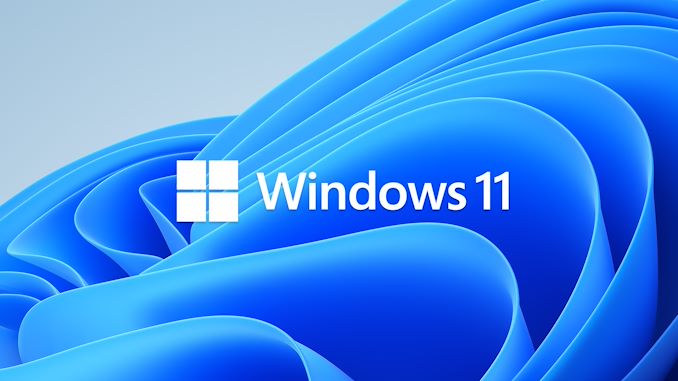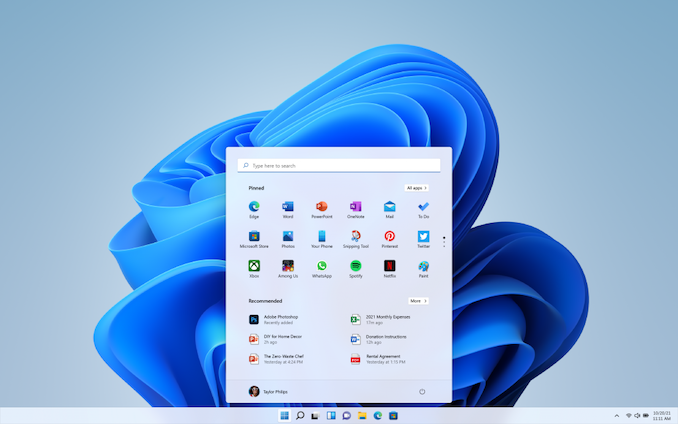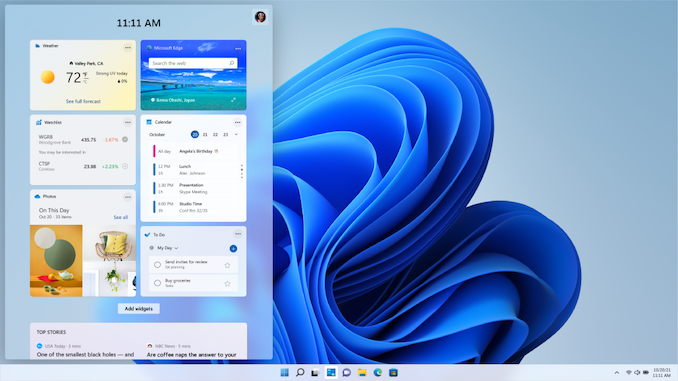What to Expect with Windows 11: A Day One Hands-On
by Brett Howse on October 4, 2021 4:00 PM EST- Posted in
- Software
- Operating Systems
- Windows
- Microsoft
- Windows 11

Tomorrow, Microsoft is officially launching Windows 11, the next installment of their operating system which underpins the majority of PCs in use today. Windows 10 has an install base of over 1 billion devices, and Windows 11 comes into existence in a much different place than its predecessor. After the much-maligned Windows 8 there was a sense of urgency and necessity which ushered Windows 10 into the world. Windows 11, on the other hand, comes into a market where most people are happy with Windows 10. So it raises the question: Why now?
When Windows 10 launched, it was said to be the final version of Windows, and future updates would be additive to Windows 10, rather than a new version number. But that was six years ago, and times have changed, as has the management and ownership of the Windows development team at Microsoft. For better or worse, the company has deemed that now is a good time to do a clean break again, with all of the animosity and angst that will bring to a good portion of their customers, especially businesses who may still be in the process of migrating to Windows 10.
The question is why now? What is new? Why is Microsoft choosing this moment to switch from the very successful Windows 10 and implement another upgrade cycle? Some of these questions can be answered, but others will take time.
Refreshed User Interface
The immediate change that everyone will notice is that Microsoft has completely revamped the user interface for Windows 11. They have apparently gotten tired of their obsession with flat, stark interfaces and moved to a much more colorful and expressive theme.
There are also major changes to the Start Menu and the taskbar. The Start Menu has ditched the live tile idea. Although a good idea on the now defunct Windows Phone platform, live tiles never really worked well on the desktop and could make it more difficult to find the application you were looking for since the icon would change. Instead, the Start Menu goes back to basic app icons, but now with the Start Menu, by default, centered in the middle of the display.
Live tiles have been replaced with Widgets and can be accessed via a Widget icon on the taskbar. Currently the selection of Widgets is only Microsoft ones, and it will be interesting to see if this expands over time.
Tablet Mode is now gone as well, so if you liked to use Windows 10 in its more touch-friendly mode, you will likely be disappointed.
The taskbar also moves from a left-justified look to being centered, and when more applications are opened, the icons already on the task bar will shift to the left to keep things centered. Apps can also no longer customize areas of the taskbar.
The taskbar can also no longer be moved from the bottom of the display if you were someone who liked to slide it to one of the other sides of the screen, which will likely disappoint a lot of people. When your user base is over 1 billion, if even only 1% of users used a feature, that’s still 10 million people that used that feature.
Overall, the new user interface is clean, colorful, and breathes some new life into what had become a bit stale in Windows 10. Functionally, it is not drastically different than Windows 10, although moving the Start Menu from the bottom left corner where it has been since Windows was first Windows is a bold change. The loss of Live Tiles seems like a downgrade in functionality, but it does make the interface more consistent and easier to access the applications you are looking for, with widgets hoping to take up the slack. But, there is a surprising amount of customization and features that are being dropped.












95 Comments
View All Comments
relux - Monday, October 4, 2021 - link
I haven’t had any major issues with it so far (for desktop use to be clear). Virtualization through HyperV is slightly faster (running on one Epyc 7742). CPU compute performance is slightly higher than Server 2019 Datacenter, yet slightly lower than Server 2016 Datacenter (and much lower than Debian or Clear Linux). I’m not seeing any change in IO performance with Optane or NAND storage. Lots of security options that look like they’d hurt performance though. Overall it’s more of the same.cc2onouui - Wednesday, October 6, 2021 - link
Well I'm with you on the fact that android is a complete garbage compared to windows, Linux on the other hand is only a failure on a adoption, the OS have nothing to do, DirectX "and" MS support for windows apps developers is an important key factor, no matter what a superior Linux you build the users will not give up their games and apps library, games developers rarely consider Linux, the shitty android has a big store you can't ignore, a device with android installed is a shame on a compute machine, Apps stores density decides what share an OS will take, most people will buy even Xbox "one" instead of a cheaper PS5 if PS5 has only one gameDolda2000 - Wednesday, October 6, 2021 - link
>Ever since mobile came around, any semblance of real computing went out the window and it's like nobody even noticed.I realize this may sound elitist, but if you were relying on GUI programs, you were always using dumbed-down computing. If anything, I've been having more of the feeling that developers have started realizing that more and more, adopted their GUI stuff accordingly, and left the real computing to people who are comfortable with the edifices of real computing with command-line interfaces, editing config files or registry entries, programmatic interfaces, &c&c.
As someone who has always live in that world, I've only noticed "realm computing going out the window" as a thing in my peripheral vision, and I kinda understand why developers do it that way. It's just focusing the proper resources where they're needed.
AnnonymousCoward - Wednesday, October 13, 2021 - link
Microsoft doesn't give a shit about user experience. If they did, everything would open instantly, you'd be able to customize UI's including font sizes, and you'd be able to resize the Teams window to be as small as you want. They only seem to prioritize the experience of their own developers.rmfx - Monday, October 4, 2021 - link
It looks amazing! Finally good tastes in a Windows UI.Now, time to refresh all the crap that is not visible to the end-user as well.
philehidiot - Monday, October 4, 2021 - link
Hey, I rather like finding Windows 3.11 or NT remnants....Nah, you're right, it's dogshit. If it wasn't for a single bit of expensive hardware with no Linux support, I'd be on Linux right now. Instead, I get to have lots of VMs and wonder what might have been.
I do have a Windows 95 VM. It's genuinely horrific realising how responsive Windows 95 was Vs the wading through treacle that is Windows 10. I might bring back Windows RG.
GeoffreyA - Monday, October 4, 2021 - link
Right up till XP and Server 2003, things were quite fast. Vista is where the treacle got pumped in.yetanotherhuman - Tuesday, October 5, 2021 - link
It's true. Windows 7 helped a bit (mostly with regards to graphics performance and memory usage) but since then it's been nothing but bloatTheinsanegamerN - Tuesday, October 5, 2021 - link
7 was also helped by the explosion in powerful hardware. Vista came out in 2006. 7 in 2009. Larger pools of system memory, DDR2, early DDR3, high clocked dual core Core 2s and athlons and video cards with higher core counts and memory speed had replaced the widespread 64MB or less GPUs, pentium IV CPUs, and 512MB memory pool systems vista was trying to be loaded on.7 really doesnt run well on the configs that vista didnt run well on either.
GeoffreyA - Tuesday, October 5, 2021 - link
I think the secret of 7 was actually the greater polish, sanding away Vista's rough edges. Colours were noticeably toned down, there was translucency for maximised windows, bigger min/max/close buttons, rotating wallpaper, the glorious animation on the Start menu pearl, a taskbar worth its weight in gold, faster booting. It's these little touches, that last 1%, that took it into excellence Vista never reached. Yet Vista did most of the hard work.